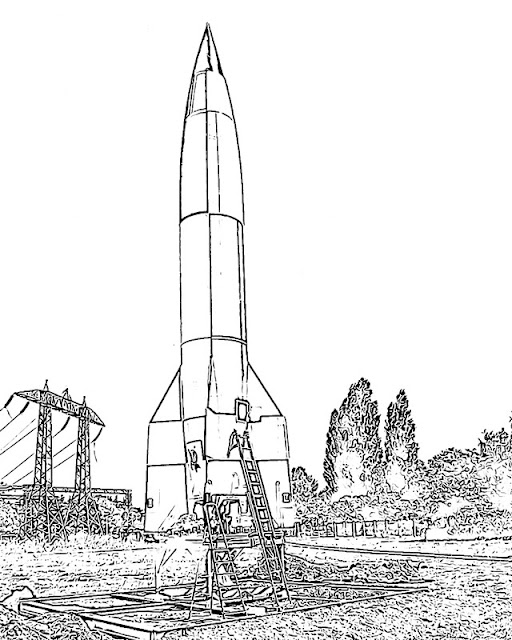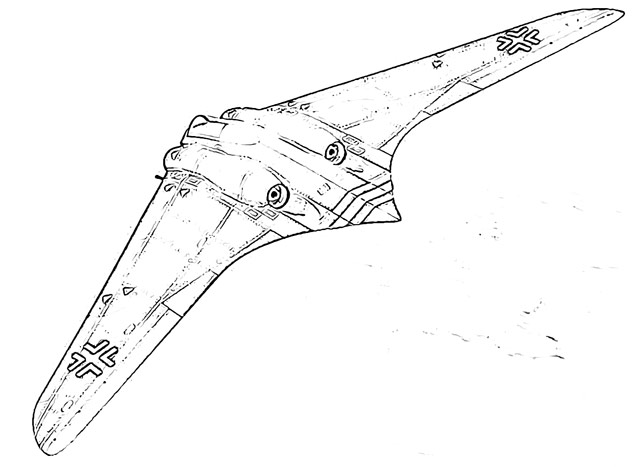Wonder Weapons of the Third Reich
 |
| A V-2 vengeance weapon in flight. |
This page is devoted to coloring pages of German superweapons of World War II. While insufficient to win the war for Germany, the superweapons were extremely important in maintaining morale within the Third Reich even as growing Allied military superiority became an inescapable fact.
It is common for people now to conclude that the superweapons were a waste of time and money. However, that ignores the fact that they gave the German government a beacon of hope that kept soldiers fighting and civilians producing weapons of war. That may have been counterproductive for the German state in the long run, but in the short run, it served as very effective propaganda that worked right up until the end of the war.
 |
| The RAF Gloster Meteor jet, an advanced Allied plane that flew and was used defensively against Luftwaffe V-1 flying missiles. |
Make no mistake, the Allies had cutting-edge weapons of their own such as the atomic bomb that helped them to win the war. They also had jet planes in various stages of development and so forth. With their country being overrun, though, the Germans were desperate and flung as many of these advanced weapons into service as they could while the Allies had the luxury of relying on their conventional weapons that, after all, were winning the war for them.
Let's look at some of these "wonder weapons" (Wunderwaffe) in no particular order.
 |
| Focke-Achgelis Fa 223 Drache. |
Both Germany and the United States developed helicopters during World War II. The Luftwaffe, however, was far ahead of the United States and actually had flying helicopters even before the war began. One of these was the Focke-Achgelis Fa 223 Drache, which had two counter-rotating rotors on booms. The helicopters were perfectly flyable and many were built, but the Luftwaffe never really figured out how to use them effectively aside from performing mundane errands such as moving heavy equipment including cannons.
 |
| Arado AR-234 bomber. |
Jet engines were the key to advanced aircraft during the 1940s. The Germans developed many planes with jet engines during World War II. One of these was the Arado AR-234 bomber. These flew and saw service during World War II. In their most famous mission, they helped to destroy the "Bridge at Remagen" that the Allies captured in March 1945. Appearing too late in the war to make any difference, the AR-234 was extremely effective and could have become much more famous if the war had lasted longer. The Arado bomber was the first purpose-built medium bomber in history and the Allies had nothing like it.
 |
| ME 163 Komet rocket plane. |
German aircraft designers were as good as any in the world. The German Luftwaffe had many advanced planes that saw combat. One of them was the Messerschmidt ME-163 Komet rocket plane. It was faster than any Allied plane and was credited with shooting down some bombers in the last year of World War II.
 |
| V-2 Rocket. |
German rocket experts such as Wernher von Braun eventually helped to land the first men on the Moon. The Germans were very advanced with rocket designs and did not hesitate to use them for military purposes during World War II. They built and fired over 3,100 of their most advanced rockets, the V-2 vengeance weapon, against London and other targets. The V-2 was a deadly weapon that killed thousands of people. There was no defense against the V-2 other than defeating Germany.
 |
| Horten Ho-229. |
The Horten brothers were glider experts who decided to try their hand at designing an advanced Luftwaffe fighter. The Luftwaffe had advanced jet engines and also plane designs that the Allies had never seen before, so the two brothers used those and developed one of the most amazing jet planes of World War II. One of these was the Horten Ho-229, a jet-powered flying wing that flew several times in 1945. The Horten Ho-229 was a revolutionary concept that closely resembles the B-2 bomber that remains in service with the United States Air Force today. Like the B-2, it had stealth characteristics and other advanced features that were not matched for decades.
 |
| U-2540 "Wilhelm Bauer." |
U-boats were a menace to Allied shipping until the very end of World War II. The German Navy (
Kriegsmarine) developed advanced submarines that saw action late in World War II. The Type XXI submarine was huge and operated off of batteries while underwater. It only had to surface to run its diesel engines to recharge its batteries, then could go underwater again for lengthy periods of time.
These submarines foreshadowed modern electric automobiles that also run off of batteries and only need to be recharged when the batteries run down. The most amazing thing about the Type XXI submarines was that, unlike all other submarines of World War II, they actually sailed faster underwater than on the surface due to their electric motors. U-2540, shown in the image, was one of the last Type XXI submarines built and was used by the post-war German Navy for decades after being refloated in the late 1950s. It literally was decades ahead of its time and remains on display at the Maritime Museum in Bremerhaven, Germany.
 |
| Schwerer Gustav artillery piece. |
Let's talk about really, really big guns. The image above shows German leader Adolf Hitler inspecting a massive artillery piece known as the Schwerer Gustav cannon. The German Army developed many huge cannons that were useful for destroying enemy bunkers. It moved on rail tracks and fired 7-ton shells from its 31.5-inch (80 cm) barrel to a distance of 29 miles (47 km). the Schwerer Gustav helped to win the battle of Sevastopol for the Germans and also was used against Leningrad.
 |
| ME-262. |
One of the most famous planes in history is the ME-262 Swallow. The Luftwaffe was the first air force to get a jet fighter into combat. this was the Messerschmidt ME-262, which had two jet engines and could outfly any other plane of World War II. The ME-262 entered service in 1944 and was a deadly threat to Allied bombers. Being faster than any Allied plane, the ME-262 could approach bombers from any direction and evade escorting fighters. While the Allies also developed jet engines and produced flyable jet aircraft that served in a defensive role, they were unable to get any jet aircraft into combat before World War II ended.
 |
| Panzer VIII Maus tank. |
If you want to talk about big tanks, the German Army had the biggest. The Germans built very big tanks as World War II continued, including the Tiger tank and the King Tiger tank. The biggest tank that they completed was the superheavy Panzer VIII Maus tank. This behemoth designed by Ferdinand Porsche weighed 188 tons, over three times that of any tank then (or now). It mounted a 128 mm (5 in) main gun that was able to destroy any other tank of its time. The Maus came along too late to see service during World War II, but two were completed and one may have fired a few shells at the enemy before being destroyed to avoid capture.
 |
| V-1 flying bomb. |
Some wonder weapons were very effective. While overshadowed by its flashier companion the V-2 rocket, the V-1 flying bomb was actually deadlier. They killed over 6,000 people in Great Britain, primarily within London, about three times as many as the V-2. The V-1 was slower than the V-2 and fast Allied fighters could match their speed and "tip" them off course, but they also were much cheaper and quicker to build and thus, in a strategic sense, more useful. In fact, the Allies were so fearful of the V-1 that they tailored their military strategy after the D-Day landings around occupying their launching sites. The V-1 is the direct ancestor of modern cruise missiles that remain in use today.
2021












No comments:
Post a Comment